Only experienced gardeners know what is a tour of the tour and how to grow it. Some have heard of this rare root root, many even know how it looks outwardly, tried to taste and want to grow it on their plot.
Many since Soviet times are associated with a feed culture, because in the last century this culture was grown in order to feed the cattle. In Russia, the tour pack was not so common, as in the southern part of Europe and in Greece.
Turnip - what is this plant
This is one of the varieties of trousers. From a long time, people have used the tournament in food and appreciated it, as we now appreciate the bread (according to food value). Then, when potatoes appeared, he gradually began to forget about the tour. Currently, small touration tourations are grown in the United States and Germany, as well as Australia and Denmark, but more as a fodder culture. And only a small part of plantations is covered by unique table varieties of the tour.
Outwardly, this garden culture is similar to radish or radish, only larger. The flesh is delicious, sweet and juicy, so it is used in the food in the cheese. From the tour, good salads that are served in restaurants to meat and fish. Soups are prepared from the tournament with the addition of vegetables, put into the okroshka. In Japanese cuisine, the Turnip is an integral part of the Soup "MISO popular in Japan. In addition to consuming in raw form, the tour parse is easily amenable to thermal processing: it can be extended and even fry.
Turnip. Photo:
What a tour panel looks like
The tour project refers to the "cabbage" family, this is one of the varieties of the trousers, obtained by crossing the fodder and the trousers. As a result of the successful work of breeders, root crops grow properly rounded form, less often - there is a renewed form. The peel is pale light, closer to the base is painted in a purple shade, the skin is dense, and the pulp is juicy and sweetish. The color of the tour includes it can be different: yellowish, creamy, white - depending on the variety and conditions of cultivation.
Currently there are many varieties and species of this plant that can be eaten. Difference: in shape, color of the pulp, taste and composition. In some varieties there are more trace elements, but getting a rich harvest is not easy. Some varieties are distinguished by the fact that they give a shame, which is also well stored.
Turnip is divided into 2 varieties: this is a variety of yellow pulp, which is accepted to call "Zhestyamy" or a trouser grade with a flesh of white.
Consider the popular trend ranges that can be raised in Russia:
- the grade "Yellow Violet" - the trouser grows with green beautiful leaves, root from above (overhead part) are painted in a purple shade, and what remains not in sight - in white. There are not much roots, there is a plus of this variety, so harvest is very easy to collect. The pulp is very sweet and juicy, not solid;
- the "Long Bortfeld" grade - tops are not too developed, but the leaves of a juicy green color. The root ripens with yellow peel, half looks from under the ground. Due to the highly developed root system, the harvest is hampered. Grade sweet and tasty;
- another interesting variety of trousers is "Grayson", the above-ground part is painted in green, and what is in the ground is yellow. It is used as a feed grade, because the flesh is not so juicy and tasty;
- the white or "white" "white ball" variety - was bred not so long ago and managed to gain popularity among gardeners. It is distinguished by impressive sizes, the color is standard - the above-ground part is purple, then - white. Sweet flesh of white, roots are a bit, so it is not difficult to extract from the ground;
- Six-week Turnips - white roof root without transitions, the flesh is sweet and very juicy, light. Round shape vegetable, slightly spoiled.
Growing tours
It is not so difficult to grow a brute in the country area as a newcomer may appear. The culture is unpretentious in care, so when complying with the standard rules of cultivation, summer houses collect a good harvest.
In the first year of cultivation - only the collection of roots. The plant forms also the outlet of the leaves, and if seeds are needed - then the trouser is left for the second year.
The leaves are pubescent more from the fodder varieties, and smooth - in salad. The form can be different, the classic is a ball-shaped tour package of the right shape, a slightly flattened ball, the elongated fetus, slightly elongated.
Flowers appear on the second year of cultivation, beautiful yellow. Fruits are elongated pods. Seeds of a tour paper - red or black.
How to grow a tournament from seeds
Culture is easy to grow, from seeds it is easy to get a good harvest.
Seed Turnips:
- you can sow seeds in open soil immediately (a little later), but you can grow seedlings. What and we will do. First you need to go through the planting material, remove dry, empty seeds. And all the good, put in a tire with salt water. This is a verification step, thanks to which seeds are selected. Those that surfaced are empty, they need to be collected and thrown away, and those that remained are suitable for growing seedlings;
- before boarding another test: you need to hold a minute of seeds in a weak solution of manganese. This is the standard disinfection procedure;
- then the seeds are soaked in the water room temperature so that they will be poisoned by moisture. Such sowing material germinates faster;
- sowing time: in early April or at any time, but 1.5 months before the expected landing in open soil seedlings;
- the dining room seeds are very small, they need to be mixed with sainted small sand to sow evenly;
- for sowing, take peophers, it is more convenient to grow seedlings and then there will be no problems with a transplant;
- after sowing seeds, they must be tricked by a layer of sand (1 cm), moisten the top layer of the spray gun, cover with a film;
- cups need to put on a warm window sill. So that the seedlings develop correctly, the temperature regime is required. For seedlings, the optimal temperature from +5 to +15 degrees. The place must be shaded, without direct sunlight;
- when shoots appear, it does not avoid thinning. Leave only strong seedlings. Only when you cut forward, keep in mind that pulling weak sprouts just with the root is undesirable, as they can damage the neighboring. Here you need another approach: sprouting rechoup;
- how to care for seedlings: timely watering and soil looser;
- feeding young shoots: mineral additives;
- 14 days before landing in the ground, you will need to harden the seedlings. Sprouts are put on the street or put on the balcony, first for 5 minutes, gradually increasing the time of staying on the street. In the last days, seedlings should remain outside the whole day;
- soil preparation: If the soil is acidic, it will take a lime. If nothing is done, the plant adapts and grows on any soils, only the crop will not last long;
- when transplanting, choose warm days, usually in the second half of May just ruffles the weather. In freezing, seedlings are not planted.
Tips for the preparation of the soil before landing: Brubva loves fertile soils, so the preparation of the soil must be performed since the autumn. At first Packet of the Earth, then making the manure (only not fresh!), Wood ash and nitroposka.
Fresh manure is destroyed for the tour, as a juicy of the root and taste is lost, they can crack.
After which plants you can and can not land a fodder turnip? After growing any cruciferous and cabbage. You can land the tournament on this place only after 4 years! And the best predecessor cultures are beets, winter and tark grain, strawberries, any one-weary herbs.
Sowing Tourneps Seeds in Open Soil
For those who do not want to mess around with a sediment or missed time, there is another way to plant a tour step in open soil seeds.
How to do everything right:
- In late April-May, the first numbers of June, prepare the ground for landing. The affairs of the groove with a distance of 20 cm.
- Sowing depth - no more than 2 cm.
- Prepared seeds (past calibration, disinfection, swollen), mixed with sand, bezed into a slightly moistened soil.
- The depth of the seal is 1.5-2 cm, mulching - peat or dry earth.
- When the first shoots appear (approximately the 5th day), after irrigation, the soil must be gently explode.
- When the first shoots with 3 full-fledged leaves appear, it's time to have thinning. Experience the sprouts carefully, if they are too closely "sitting", then - only rechouping under the root.
- A little later, you will need another 1-2 thinning, then we look at the situation.
- Timely irrigation, loosening will lead to a large harvest of a juicy and sweet tour.
Care and making feedback for tour
There is no special care for the cutlery replica, the main thing is to loosen and water the soil in time. Regarding watering there are recommendations: Turnips does not like the mooring soil, but in the period of active growth it is impossible to neglect watering. If you don't water the garden culture at all (for example, in a strong heat), then the rootes will be impatient. The optimal frequency of watering is 2 times a week, if there was no precipitation during this period.
The soil is moderately wet, but not overpowered, watering the standard, but so that the ground is not washed away. If the roaster comes from the top of the root, the tour will become a green shade and all nutrients will be lost.
There is nothing complex in the feeding: in the period of growth, the plant should be filled with a bird litter: 1 part of the litter, 15 parts of water. If there is no organic fertilizer at hand, nitroposka is suitable. You can make fertilizers no more than 2 times a season.
Protection against pests and diseases of the tour
The plant although hardy, but it is like to attack parasites: it is a word, bugs (rapeseed), fleece and flies. You can get rid of annoying pests in different ways: folk and chemicals. If you do not want to deal with chemistry, then make a sturdy calendula or velvetsev. It also helps in the fight against these pests of the infusion of garlic.
And from the chemistry will help to get rid of blinds, flies, etc. Such drugs: "Aktara" or "Aktellik".
Tourneps diseases:
- bacteriosis vascular;
- mosaic;
- keel;
- blackleg.
Timely treatment of fungicides ("Phytosporin") will help protect the future harvest. But the introduction of chemicals can be avoided if you comply with the right crop rotation.
When to remove the tour?
From the moment of sowing seeds in open ground, 6 weeks allocated for the ripening of this garden crop. How to understand that it is time to collect a crop? As soon as you noticed that the leaves from the bottom began to turn yellow, the root or became dry, it's time to dig root.
If the seeds sowed the seeds, they begin at the end of June, but they need to take into account climatic conditions. Such roots are more suitable for eating in the near future, since they are not intended for long-term storage.
Cleaning the ripened trousers in the early autumn (September-October) will allow sending a crop for long-term storage. Terms of cleaning - depend on the variety of the plant.
In no case cannot wait until the temperature drops down below the minus 6 degrees, then the root plates can freeze, become flabbles and they will not be able to store for a long time.
Rules for the assembly of rootfodes:
- in the country area, the roots are harvested manually, if it is large fields - special equipment will come to the aid;
- bottva need to cut and give a cattle;
- vilails or copal neatly remove the roots from the ground;
- as you dig up - fold into the row to swept the raw land;
- then all the roots must be collected in one place, remove dry lumps of the earth and, if necessary, dry;
- it is preferably stored in a cellar or basement at a temperature of 0 +2 degrees, recommended humidity in a room 90%;
- for storage for the winter, the best, elastic and without damage to the root corners are selected. It is cut off to storing the tops, it is left at a base of 1.5-2 cm;
- you can store a tour pack in the trench, only then you need to cover the crop peat and on top of the material that does not miss moisture.
The benefits, harm and contraindications to the tour
The fruits of the dining room are rich in vitamin C, minerals and microelements. In the composition there are such integrable trace elements such as zinc, iron and selenium, as well as calcium, magnesium, phosphorus and others. There is a small proportion of mustard oil in the reaches of the tour. Fruits diet and not calories, 200 g of meakty contains only 60 calories.
Turnip use:
- promotes blood dilution, therefore it is used as a prophylactic agent in combating platelets;
- normalizes pressure, strengthens the vessels;
- excellent diuretic, sweatshoot;
- it has wound-healing properties, and if you make the compress to the patient, relieves pain;
- powerful antiseptic and antiviral remedy, well soothes with nervous overvoltage;
- improves thinking and memory;
- beneficiously affects the work of the stomach and intestines, as in the repex a lot of fiber. Will help get rid of constipation;
- improves the condition of patients with such diseases: diabetes, osteochondrosis, gout, polyneurite;
- contributes to the elimination of helminths.
On the dangers and contraindications, you can say the following: if you excessively eating a tour paper, a bloating, pain in the stomach and intestines, headache, weakness may appear. Therefore, if such symptoms are present, it is necessary to abandon the use of trousers for a while.
Contraindications:
- people with gastritis and increased acidity there is a tour package undesirable;
- in hypothyroidism, the use of trousers is limited;
- it is impossible to eat a tour step in varicose veins, jade and hypertensive crisis.
Now you know how to grow a tour panel on the site, you can collect a rich harvest. But how to diversify the menu, our tips will help.
They use the tournament in raw form, added to salads, solo is served to meat and fish dishes.
An interesting prescription of the preparing of trousers grown with their own hands:
- We take a piece of low-fat pork weighing 600 g., Cut into portion pieces, fold into the scenery.
- Grind 2-3 root projects or 500 g.
- Shinkum red onions - 2 pcs.
- We refuel sauce from salt, garlic, ground pepper, cumin (optional), honey - 2 tbsp, soy sauce - 3 tbsp.
- All mixed, put the cutter in the oven, prepare for 1 hour 20 minutes at a temperature of 180 degrees.
- Before feeding, we enrich the prepared dish with a pinch of spices and finely chopped fresh greens.

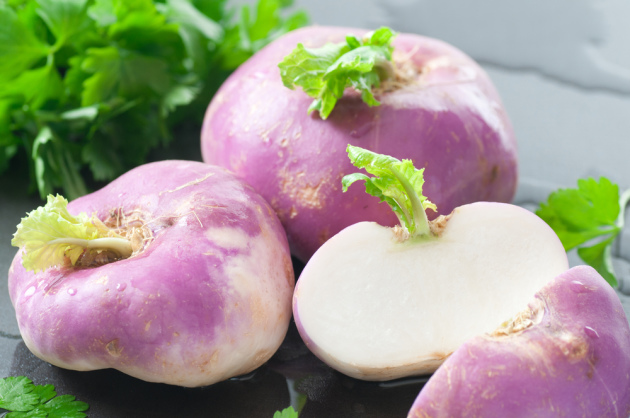
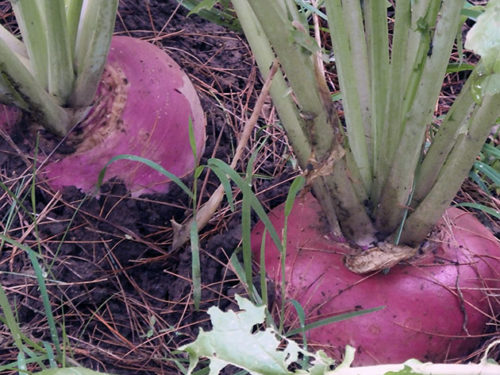
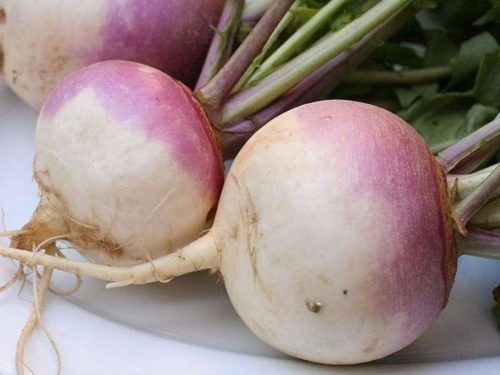
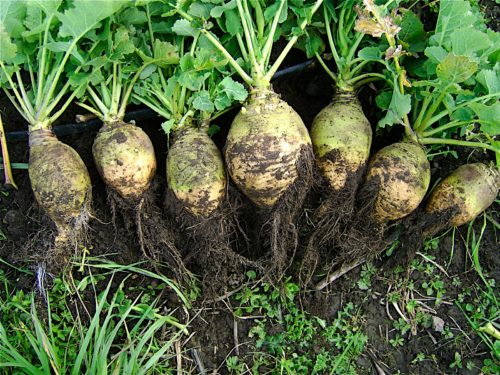
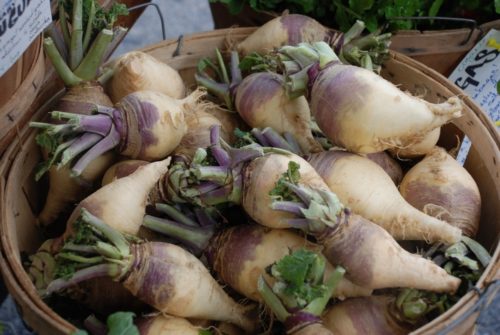
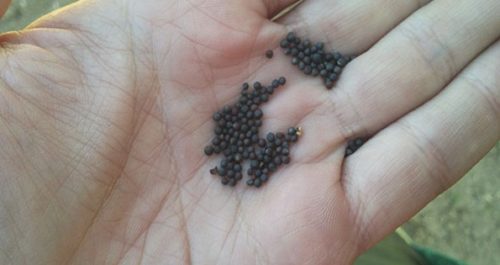

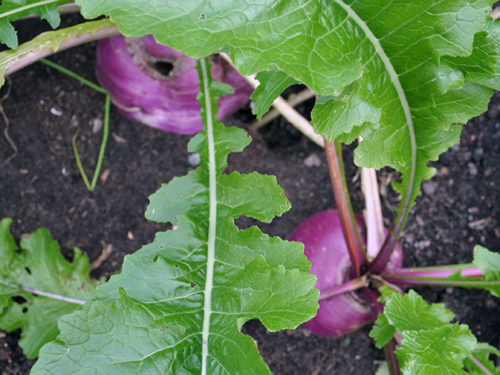
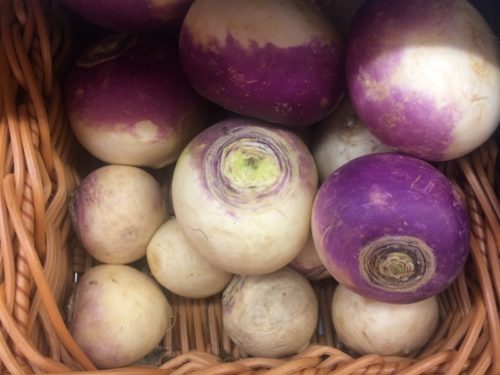
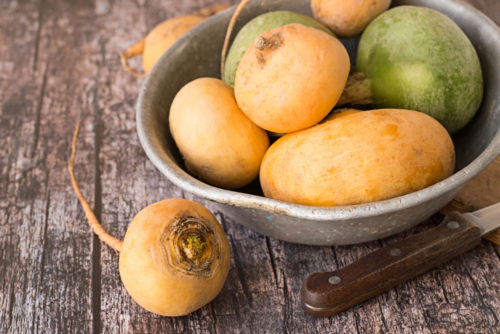












 Start a discussion ...
Start a discussion ...